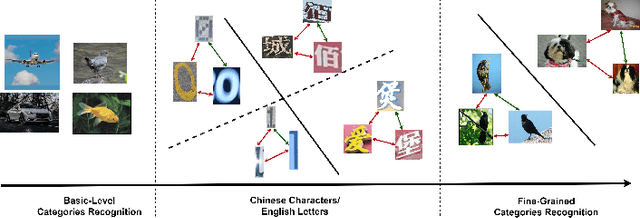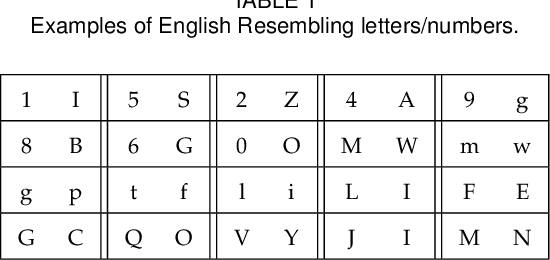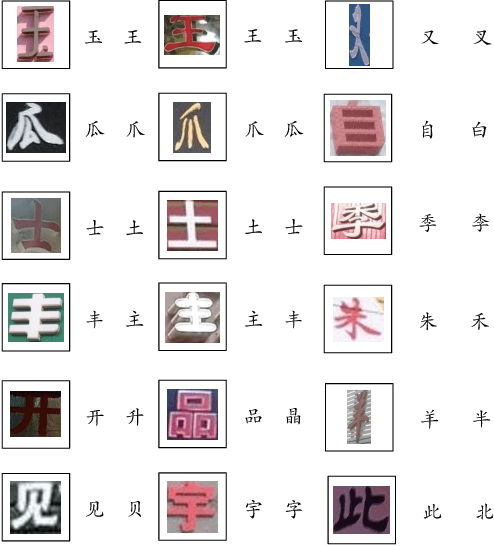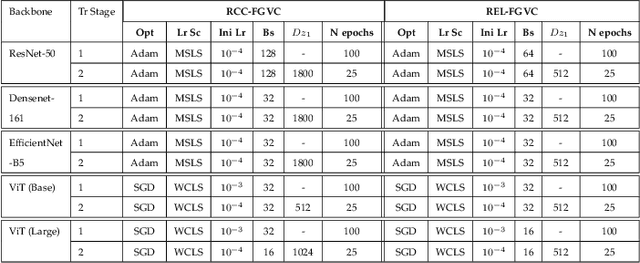Fadi Dornaika
IMT
Extremely Fine-Grained Visual Classification over Resembling Glyphs in the Wild
Aug 25, 2024



Abstract:Text recognition in the wild is an important technique for digital maps and urban scene understanding, in which the natural resembling properties between glyphs is one of the major reasons that lead to wrong recognition results. To address this challenge, we introduce two extremely fine-grained visual recognition benchmark datasets that contain very challenging resembling glyphs (characters/letters) in the wild to be distinguished. Moreover, we propose a simple yet effective two-stage contrastive learning approach to the extremely fine-grained recognition task of resembling glyphs discrimination. In the first stage, we utilize supervised contrastive learning to leverage label information to warm-up the backbone network. In the second stage, we introduce CCFG-Net, a network architecture that integrates classification and contrastive learning in both Euclidean and Angular spaces, in which contrastive learning is applied in both supervised learning and pairwise discrimination manners to enhance the model's feature representation capability. Overall, our proposed approach effectively exploits the complementary strengths of contrastive learning and classification, leading to improved recognition performance on the resembling glyphs. Comparative evaluations with state-of-the-art fine-grained classification approaches under both Convolutional Neural Network (CNN) and Transformer backbones demonstrate the superiority of our proposed method.
D-TrAttUnet: Toward Hybrid CNN-Transformer Architecture for Generic and Subtle Segmentation in Medical Images
May 07, 2024Abstract:Over the past two decades, machine analysis of medical imaging has advanced rapidly, opening up significant potential for several important medical applications. As complicated diseases increase and the number of cases rises, the role of machine-based imaging analysis has become indispensable. It serves as both a tool and an assistant to medical experts, providing valuable insights and guidance. A particularly challenging task in this area is lesion segmentation, a task that is challenging even for experienced radiologists. The complexity of this task highlights the urgent need for robust machine learning approaches to support medical staff. In response, we present our novel solution: the D-TrAttUnet architecture. This framework is based on the observation that different diseases often target specific organs. Our architecture includes an encoder-decoder structure with a composite Transformer-CNN encoder and dual decoders. The encoder includes two paths: the Transformer path and the Encoders Fusion Module path. The Dual-Decoder configuration uses two identical decoders, each with attention gates. This allows the model to simultaneously segment lesions and organs and integrate their segmentation losses. To validate our approach, we performed evaluations on the Covid-19 and Bone Metastasis segmentation tasks. We also investigated the adaptability of the model by testing it without the second decoder in the segmentation of glands and nuclei. The results confirmed the superiority of our approach, especially in Covid-19 infections and the segmentation of bone metastases. In addition, the hybrid encoder showed exceptional performance in the segmentation of glands and nuclei, solidifying its role in modern medical image analysis.
Artificial Intelligence in Bone Metastasis Analysis: Current Advancements, Opportunities and Challenges
Apr 30, 2024Abstract:In recent years, Artificial Intelligence (AI) has been widely used in medicine, particularly in the analysis of medical imaging, which has been driven by advances in computer vision and deep learning methods. This is particularly important in overcoming the challenges posed by diseases such as Bone Metastases (BM), a common and complex malignancy of the bones. Indeed, there have been an increasing interest in developing Machine Learning (ML) techniques into oncologic imaging for BM analysis. In order to provide a comprehensive overview of the current state-of-the-art and advancements for BM analysis using artificial intelligence, this review is conducted with the accordance with PRISMA guidelines. Firstly, this review highlights the clinical and oncologic perspectives of BM and the used medical imaging modalities, with discussing their advantages and limitations. Then the review focuses on modern approaches with considering the main BM analysis tasks, which includes: classification, detection and segmentation. The results analysis show that ML technologies can achieve promising performance for BM analysis and have significant potential to improve clinician efficiency and cope with time and cost limitations. Furthermore, there are requirements for further research to validate the clinical performance of ML tools and facilitate their integration into routine clinical practice.
Rethinking Attention Gated with Hybrid Dual Pyramid Transformer-CNN for Generalized Segmentation in Medical Imaging
Apr 28, 2024Abstract:Inspired by the success of Transformers in Computer vision, Transformers have been widely investigated for medical imaging segmentation. However, most of Transformer architecture are using the recent transformer architectures as encoder or as parallel encoder with the CNN encoder. In this paper, we introduce a novel hybrid CNN-Transformer segmentation architecture (PAG-TransYnet) designed for efficiently building a strong CNN-Transformer encoder. Our approach exploits attention gates within a Dual Pyramid hybrid encoder. The contributions of this methodology can be summarized into three key aspects: (i) the utilization of Pyramid input for highlighting the prominent features at different scales, (ii) the incorporation of a PVT transformer to capture long-range dependencies across various resolutions, and (iii) the implementation of a Dual-Attention Gate mechanism for effectively fusing prominent features from both CNN and Transformer branches. Through comprehensive evaluation across different segmentation tasks including: abdominal multi-organs segmentation, infection segmentation (Covid-19 and Bone Metastasis), microscopic tissues segmentation (Gland and Nucleus). The proposed approach demonstrates state-of-the-art performance and exhibits remarkable generalization capabilities. This research represents a significant advancement towards addressing the pressing need for efficient and adaptable segmentation solutions in medical imaging applications.
Fair Graph Neural Network with Supervised Contrastive Regularization
Apr 09, 2024Abstract:In recent years, Graph Neural Networks (GNNs) have made significant advancements, particularly in tasks such as node classification, link prediction, and graph representation. However, challenges arise from biases that can be hidden not only in the node attributes but also in the connections between entities. Therefore, ensuring fairness in graph neural network learning has become a critical problem. To address this issue, we propose a novel model for training fairness-aware GNN, which enhances the Counterfactual Augmented Fair Graph Neural Network Framework (CAF). Our approach integrates Supervised Contrastive Loss and Environmental Loss to enhance both accuracy and fairness. Experimental validation on three real datasets demonstrates the superiority of our proposed model over CAF and several other existing graph-based learning methods.
Ensembling and Test Augmentation for Covid-19 Detection and Covid-19 Domain Adaptation from 3D CT-Scans
Mar 17, 2024



Abstract:Since the emergence of Covid-19 in late 2019, medical image analysis using artificial intelligence (AI) has emerged as a crucial research area, particularly with the utility of CT-scan imaging for disease diagnosis. This paper contributes to the 4th COV19D competition, focusing on Covid-19 Detection and Covid-19 Domain Adaptation Challenges. Our approach centers on lung segmentation and Covid-19 infection segmentation employing the recent CNN-based segmentation architecture PDAtt-Unet, which simultaneously segments lung regions and infections. Departing from traditional methods, we concatenate the input slice (grayscale) with segmented lung and infection, generating three input channels akin to color channels. Additionally, we employ three 3D CNN backbones Customized Hybrid-DeCoVNet, along with pretrained 3D-Resnet-18 and 3D-Resnet-50 models to train Covid-19 recognition for both challenges. Furthermore, we explore ensemble approaches and testing augmentation to enhance performance. Comparison with baseline results underscores the substantial efficiency of our approach, with a significant margin in terms of F1-score (14 %). This study advances the field by presenting a comprehensive methodology for accurate Covid-19 detection and adaptation, leveraging cutting-edge AI techniques in medical image analysis.
Hand-Eye Calibration
Nov 22, 2023Abstract:Whenever a sensor is mounted on a robot hand it is important to know the relationship between the sensor and the hand. The problem of determining this relationship is referred to as hand-eye calibration, which is important in at least two types of tasks: (i) map sensor centered measurements into the robot workspace and (ii) allow the robot to precisely move the sensor. In the past some solutions were proposed in the particular case of a camera. With almost no exception, all existing solutions attempt to solve the homogeneous matrix equation AX=XB. First we show that there are two possible formulations of the hand-eye calibration problem. One formulation is the classical one that we just mentioned. A second formulation takes the form of the following homogeneous matrix equation: MY=M'YB. The advantage of the latter is that the extrinsic and intrinsic camera parameters need not be made explicit. Indeed, this formulation directly uses the 3 by 4 perspective matrices (M and M') associated with two positions of the camera. Moreover, this formulation together with the classical one cover a wider range of camera-based sensors to be calibrated with respect to the robot hand. Second, we develop a common mathematical framework to solve for the hand-eye calibration problem using either of the two formulations. We present two methods, (i) a rotation then translation and (ii) a non-linear solver for rotation and translation. Third, we perform a stability analysis both for our two methods and for the classical linear method of Tsai and Lenz (1989). In the light of this comparison, the non-linear optimization method, that solves for rotation and translation simultaneously, seems to be the most robust one with respect to noise and to measurement errors.
Visually Guided Object Grasping
Nov 21, 2023Abstract:In this paper we present a visual servoing approach to the problem of object grasping and more generally, to the problem of aligning an end-effector with an object. First we extend the method proposed by Espiau et al. [1] to the case of a camera which is not mounted onto the robot being controlled and we stress the importance of the real-time estimation of the image Jacobian. Second, we show how to represent a grasp or more generally, an alignment between two solids in 3-D projective space using an uncalibrated stereo rig. Such a 3-D projective representation is view-invariant in the sense that it can be easily mapped into an image set-point without any knowledge about the camera parameters. Third, we perform an analysis of the performances of the visual servoing algorithm and of the grasping precision that can be expected from this type of approach.
Simultaneous Robot-World and Hand-Eye Calibration
Nov 20, 2023Abstract:Recently, Zhuang, Roth, \& Sudhakar [1] proposed a method that allows simultaneous computation of the rigid transformations from world frame to robot base frame and from hand frame to camera frame. Their method attempts to solve a homogeneous matrix equation of the form AX=ZB. They use quaternions to derive explicit linear solutions for X and Z. In this short paper, we present two new solutions that attempt to solve the homogeneous matrix equation mentioned above: (i) a closed-form method which uses quaternion algebra and a positive quadratic error function associated with this representation and (ii) a method based on non-linear constrained minimization and which simultaneously solves for rotations and translations. These results may be useful to other problems that can be formulated in the same mathematical form. We perform a sensitivity analysis for both our two methods and the linear method developed by Zhuang et al. This analysis allows the comparison of the three methods. In the light of this comparison the non-linear optimization method, which solves for rotations and translations simultaneously, seems to be the most stable one with respect to noise and to measurement errors.
D-TrAttUnet: Dual-Decoder Transformer-Based Attention Unet Architecture for Binary and Multi-classes Covid-19 Infection Segmentation
Mar 27, 2023Abstract:In the last three years, the world has been facing a global crisis caused by Covid-19 pandemic. Medical imaging has been playing a crucial role in the fighting against this disease and saving the human lives. Indeed, CT-scans has proved their efficiency in diagnosing, detecting, and following-up the Covid-19 infection. In this paper, we propose a new Transformer-CNN based approach for Covid-19 infection segmentation from the CT slices. The proposed D-TrAttUnet architecture has an Encoder-Decoder structure, where compound Transformer-CNN encoder and Dual-Decoders are proposed. The Transformer-CNN encoder is built using Transformer layers, UpResBlocks, ResBlocks and max-pooling layers. The Dual-Decoder consists of two identical CNN decoders with attention gates. The two decoders are used to segment the infection and the lung regions simultaneously and the losses of the two tasks are joined. The proposed D-TrAttUnet architecture is evaluated for both Binary and Multi-classes Covid-19 infection segmentation. The experimental results prove the efficiency of the proposed approach to deal with the complexity of Covid-19 segmentation task from limited data. Furthermore, D-TrAttUnet architecture outperforms three baseline CNN segmentation architectures (Unet, AttUnet and Unet++) and three state-of-the-art architectures (AnamNet, SCOATNet and CopleNet), in both Binary and Mutli-classes segmentation tasks.
 Add to Chrome
Add to Chrome Add to Firefox
Add to Firefox Add to Edge
Add to Edge